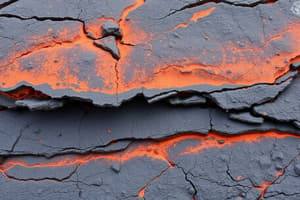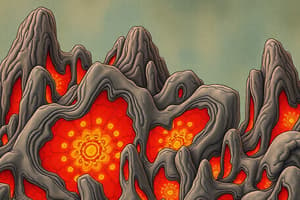Podcast
Questions and Answers
Which of the following is NOT a typical characteristic of magma?
Which of the following is NOT a typical characteristic of magma?
- Typically immobile and cold (correct)
- May contain crystals
- Contains dissolved gases
- Molten rock material
What does the term 'extrusion' refer to in the context of igneous rocks?
What does the term 'extrusion' refer to in the context of igneous rocks?
- The partial melting of rocks within the Earth's mantle
- The process of magma cooling and solidifying beneath the Earth's surface
- The formation of crystals within magma
- The process of magma reaching the Earth's surface (correct)
Which of the following is the MOST accurate description of the texture of an igneous rock?
Which of the following is the MOST accurate description of the texture of an igneous rock?
- The overall appearance related to the size, shape, and arrangement of minerals (correct)
- The chemical composition of the rock
- The age of the rock formation
- The specific gravity of the rock
Which type of igneous texture indicates slow cooling and the formation of large crystals that are visible without magnification?
Which type of igneous texture indicates slow cooling and the formation of large crystals that are visible without magnification?
What is the primary difference between extrusive and intrusive structures in igneous rocks?
What is the primary difference between extrusive and intrusive structures in igneous rocks?
What is the MOST defining characteristic of concordant intrusive structures?
What is the MOST defining characteristic of concordant intrusive structures?
A geologist discovers a large intrusive body that covers an area of 50 square miles. Based on size alone, how would this body be classified?
A geologist discovers a large intrusive body that covers an area of 50 square miles. Based on size alone, how would this body be classified?
Which type of igneous rock is formed from the violent eruption of volcanic materials, consisting of ash, lapilli, blocks, and bombs?
Which type of igneous rock is formed from the violent eruption of volcanic materials, consisting of ash, lapilli, blocks, and bombs?
How are igneous rocks classified based on chemical composition?
How are igneous rocks classified based on chemical composition?
Which of the following is a characteristic of ultra-basic igneous rocks?
Which of the following is a characteristic of ultra-basic igneous rocks?
Flashcards
Igneous Rock
Igneous Rock
Rock formed from cooled and solidified magma or lava.
Petrology
Petrology
The science dealing with the study of rocks
Magma
Magma
Molten rock material, containing dissolved gases, solids, and water vapor, typically generated in the lower crust and upper mantle due to partial melting of rocks.
Extrusion
Extrusion
Signup and view all the flashcards
Crystallization
Crystallization
Signup and view all the flashcards
Texture of Igneous Rocks
Texture of Igneous Rocks
Signup and view all the flashcards
Phaneritic Texture
Phaneritic Texture
Signup and view all the flashcards
Aphanitic Texture
Aphanitic Texture
Signup and view all the flashcards
Lava Flows
Lava Flows
Signup and view all the flashcards
Pyroclastic Deposit
Pyroclastic Deposit
Signup and view all the flashcards
Study Notes
- Igneous is derived from a Greek word meaning fire-formed rock.
- Petrology is the science of rocks, where petro means rock in Greek.
- Igneous rocks are also referred to as magmatic rocks because the term magmatic comes from magma.
- Magma is molten rock material that is hot, mobile, and usually contains dissolved gases, solids (crystals), and water vapor.
- Magma is generated in the lower crust and upper mantle due to partial melting of rocks under favorable pressure and temperature conditions.
- Droplets of magma combine to form large magma bodies or chambers, which move upward due to buoyancy and pressure reduction.
- Extrusion is the process of magma reaching the Earth's surface, which is called a volcano where eruption takes place violently or non-violently.
- When magma reaches the Earth's surface, it is called lava.
- The cooling of magma or lava results in the formation of crystals, a process called crystallization, which leads to the creation of solid igneous or magmatic rocks.
Textures in Igneous Rocks
- Texture refers to the overall appearance of a rock, related to the size, shape, and arrangement of minerals.
- The texture of an igneous rock is associated with its cooling history, not its chemistry.
- Phaneritic texture (coarse-grained) is plutonic, where individual grains are visible to the naked eye and can be identified using mineral properties without a lens.
- Aphanitic texture (fine-grained) is volcanic, where individual grains cannot be seen with the naked eye.
- Glassy texture is not crystalline.
Structures in Igneous Rocks
- Volcanic or extrusive rocks form when lava cools and solidifies on the Earth's surface.
- Plutonic or intrusive rocks form when magma cools and solidifies below the Earth's surface.
Extrusive Structures
- Lava flows are molten rock moving at varying speeds downhill, solidifying to form a volcanic rock.
- Pyroclastic structures are accumulations of explosively erupted volcanic materials solidified in the atmosphere.
- Ash deposits are pyroclastic deposits composed of very fine materials.
- Tuff deposits are explosively erupted, fine-grained materials that weld together when deposited hot.
Intrusive Structures
- Concordant intrusives are parallel to structures in the country rock, such as laccoliths, lopoliths, phacoliths, and sills.
- Discordant intrusives cross-cut structures in the country rock, such as batholiths, stocks, dikes, and veins.
- Intrusives are classified by shape, size, and emplacement mechanism.
- Sheet intrusives have two dimensions greater than the third, like dikes, which are sheet-like bodies vertical or nearly vertical.
- Sills are sheet-like bodies parallel to country rock, either horizontal or inclined if the rocks are disturbed.
- Lens-shaped intrusives include laccoliths (plano-convex, causing upward warping), lopoliths (convexo-concave, in synclines or basins), and phacoliths (concave-convexo, in anticlines).
- Subjacent intrusives are large with no visible floor, including batholiths (more than 40 sq. miles) and stocks (less than 40 sq. miles).
Classification of Igneous Rocks
- Four main classification systems exist: by formation and mode of occurrence, chemical composition, chemical and mineralogical criteria, and the Streckeisen classification.
- Igneous rocks are classified by formation and mode of occurrence as pyroclastic, volcanic, hypabyssal, and plutonic.
- Pyroclastic rocks form when volcanoes erupt violently, and lava cools rapidly in the atmosphere, consisting of ash (<2mm), lapilli (2-64mm), blocks (angular >64mm), and bombs (rounded >64mm).
- Volcanic rocks form when lava comes to the Earth's surface and cools rapidly, resulting in fine-grained rocks or sometimes volcanic glass.
- Hypabyssal rocks form from small igneous bodies like sills or dikes close to the Earth's surface, cooling at a rate resulting in medium-sized grains.
- Plutonic rocks form when magma cools in the upper crust at a very slow rate, leading to coarse to very coarse-grained rocks.
- Igneous rocks are classified by chemical composition based on SiO2 percentage.
- Ultra-basic rocks have less than 45% SiO2.
- Basic rocks have 45-52% SiO2.
- Intermediate rocks have 52-66% SiO2.
- Acid rocks have more than 66% SiO2.
- Ultra-basic rocks have less than 45% SiO2, with dominant mafic minerals, no quartz or feldspar, relatively heavy density (3.0-3.4gcm³), and colors ranging from dark green to black.
- Basic rocks have 45-52% SiO2, less than 60% feldspar, a larger amount of mafic minerals (45-50%), dark green to black color, and a density of 2.6-3.27gcm-³.
- Intermediate rocks have 52-66% SiO2, with feldspar being approximately 90% dominant, and quartz being very minimal or absent.
- Acid rocks have more than 66% SiO2, with quartz being the dominant mineral, a density of about 2.74gcm-3, and other major and minor minerals.
- The Streckeisen classification is also used (refer to the textbook).
Igneous Rocks in Sri Lanka
- Ambagaspitiya granite
- Tonigala granite
- Dolerite (dikes)
- Veins and Pegmatite
Studying That Suits You
Use AI to generate personalized quizzes and flashcards to suit your learning preferences.




